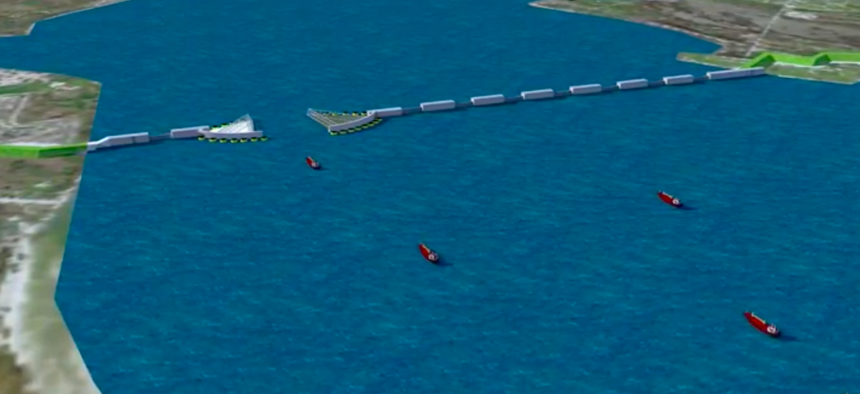Plans to Build Massive Wall to Protect Texas Move Forward

A conceptual plan for the storm barrier near Galveston, Texas that can be closed off ahead of a major hurricane. U.S. Army Corps of Engineers / Texas General Land Office
But it’s probably not the wall you’re thinking of.
Plans are moving forward to construct a massive seawall and other coastal barriers to protect the Houston Ship Canal, Galveston Bay and port facilities that support that nation’s largest petrochemical hub from hurricane-driven storm surge.
On Friday, the U.S. Army Corps of Engineers and Texas General Land Office announced the release of the Coastal Texas Protection and Restoration Study Draft Integrated Feasibility Report and Environmental Impact Statement, which the Corps described as “a first-of-its-kind feasibility study formulating risk reduction solutions to address coastal storm risks to the vast and important Texas coastline.”
Texas Land Commissioner George P. Bush said in a statement that the ”Coastal Texas Study is about protecting our people, our economy and our national security. The options selected are proven to be effective in mitigating the deadly effects of storm surge on our state. I thank the U.S. Army Corps of Engineers and look forward to continuing this vital cooperative effort.”
The release of the draft feasibility study and environmental impact statement, which includes a Tentatively Selected Plan, or TSP, doesn’t mean construction will start anytime soon. There are many steps in the process ahead. A finalized feasibility study and environmental impact statement are expected in 2021, which would then go to Congress for consideration for authorization, funding and final approval.

Much of the city of Galveston, which sits on a barrier island separating the Gulf of Mexico from Galveston Bay, is already protected by a seawall. It was built more than a century ago to protect the city from the Gulf’s waters following the nation’s deadliest natural disaster, the September 1900 hurricane that inundated the island, killing between 6,000 and 12,000 people.
Under the plan, Galveston’s existing seawall would be strengthened and additional levees would be built to protect parts of the city. Coastal flood barriers would also be built along the Bolivar Peninsula and in the channel separating it from Galveston. A movable barrier would be built to allow ships to travel between the Gulf of Mexico and the protected waters behind the wall.
While the coastal protection plan does not come with a specific price tag, the Texas Tribune reported that it’s expected that it won’t come cheap:
Combined with the recommended non-structural improvements—including 2.2 miles of dune and beach restoration along South Padre Island—the agencies estimate the plan would cost anywhere from $23 billion to $31 billion, according to a news release. An Army Corps project manager told the Tribune earlier this month that the coastal spine may cost as much as $17 billion, meaning it may make up slightly more than half the cost.
While Hurricane Harvey in 2017 very much became a nightmare disaster for the greater Houston area due to its record-setting rainfall over many days, the storm wasn’t necessarily the worst-case scenario many emergency managers and officials have long feared in southeastern Texas.
Harvey’s eye came ashore well to the south of the Houston area, near Corpus Christi, meaning that the hurricane’s strongest winds did not drive the worst of the storm surge into Galveston Bay. Hurricanes with centers that track just to the south of Galveston are at greater risk of sending significant surge into the bay and the Houston Ship Canal beyond.
Hurricane Ike in 2008, as ProPublica reported in 2016, came close to being such a nightmare storm for the Houston Ship Canal, but its track changed before landfall, sparing the area a far greater disaster. If Ike’s center had tracked 30 miles south of where it made landfall and had winds been 15 percent stronger, according to one scenario, Galveston would have seen an 11-foot storm surge; an ExxonMobil refining complex on Galveston Bay would have seen 4-foot storm surge.
The public commenting period on the Army Corps’ draft coastal protection plan ends on Jan. 9, 2019.
Michael Grass is Executive Editor of Government Executive’s Route Fifty and is based in Seattle.
NEXT STORY: Hybrid IT: Minimizing the need to choose while maximizing monitoring capabilities






